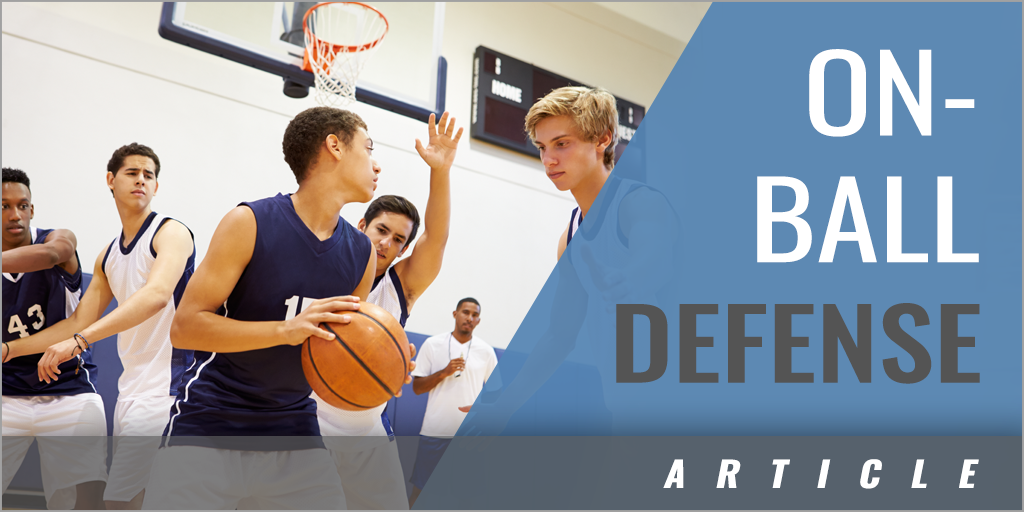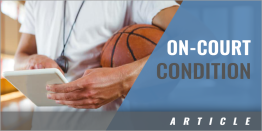|
By: Lee Rose Originally Published in: Winning Basketball Fundamentals Provided by: Human Kinetics On-the-ball defense is the term used to define the defender guarding the player with the ball. When coaches make their man-to-man defensive assignments, they must avoid matching up a slow-footed defender on a quick, penetrating offensive opponent. With more teams running motion, passing game, dribble-drive, and pick-and-roll offenses, on-the-ball defenses becomes vulnerable and are more easily exposed. Basketball players over the years have improved ballhandling and dribbling proficiency, so defenders need constant support. Therefore, to be effective, on-the-ball defense requires quick feet, lateral dexterity, and an excellent supporting cast. Contain the dribbler. The object is to stay in front of the ball to keep the offensive player from penetrating. The proper stance - bent knees, being balanced, and being prepared to slide or run - is critical. Players must learn to assess their own speed and quickness as compared with that of their opponent. If the defender perceives the opponent to be quicker, then he will have to back up a step because the goal is to avoid being beaten off the dribble. Fundamentally sound defenders do not gamble and reach, thereby putting their teammates at a disadvantage. Fake at the dribbler. This maneuver occurs in full-court and half-court situations when two offensive players with the ball attack one defender at the basket. A defender caught in a two-on-one situation must lower his body, fake a jab step at the ball handler, and slide toward the opponent without the ball, looking to deflect or steal the pass. If no pass is made, the defender then challenges the attacking offensive player. Close out under control. When an offensive player has the ball within a scoring area and the defender rotates out, the action is called a close-out. The two key aspects to closing out properly are: staying down so that the ball handler can't penetrate to the basket and being under control in a position to direct the offensive player in a predetermined direction, whether to the middle or the baseline. Contest each shot. According to Jordan Cohn, long-time NBA scout and statistical analyst, there is a 12 percent difference between a guarded shot and an open shot. Therefore, defenders should contest every shot. The technique is to get the arms up and extended to obstruct the shooter's vision. The defender should use the same-side hand for the blocking procedure. If the shooter is right-handed, the defender's left hand should be to the ball side. If the shooter is left-handed, the right hand should be to the ball side. When low-post defenders find themselves directly behind an offensive opponent, with knees locked and at a definite dis-advantage, the important goal is to avoid fouling. Instead, the defender should extend both arms as high as possible and maintain vertical position. This situation often occurs when the defender is rotating to help or when an offensive player gets a put-back. Don't foul jump shooters. Good defenders are aggressive in containing the dribbler, closing out, and contesting shots. But sometimes they are too aggressive, resulting in fouls on the jump shooter. Fouling jump shooters is not acceptable, especially on three-point attempts. When practicing close-out techniques, players must stay down with the hands up. If they jump off the floor, they are far more likely to foul the shooter. As the defender runs out to cover an open shooter and closes the distance to the offensive player, he takes smaller steps, drops his body lower, and becomes more under control. This action enables the defender to have complete body balance for contesting the shot or preventing dribble penetration. Activate the passer. Anytime the offensive player picks up the dribble, the defender should apply pressure, looking for a deflection or a steal. By picking up the dribble, the ball handler has essentially paralyzed himself When the defender applies pressure, all defenders who are one pass away should immediately overplay and be in a denial position. The defender on the ball should call out, "Deny" or "Up," communicating to teammates that pressure defense has been activated. |






